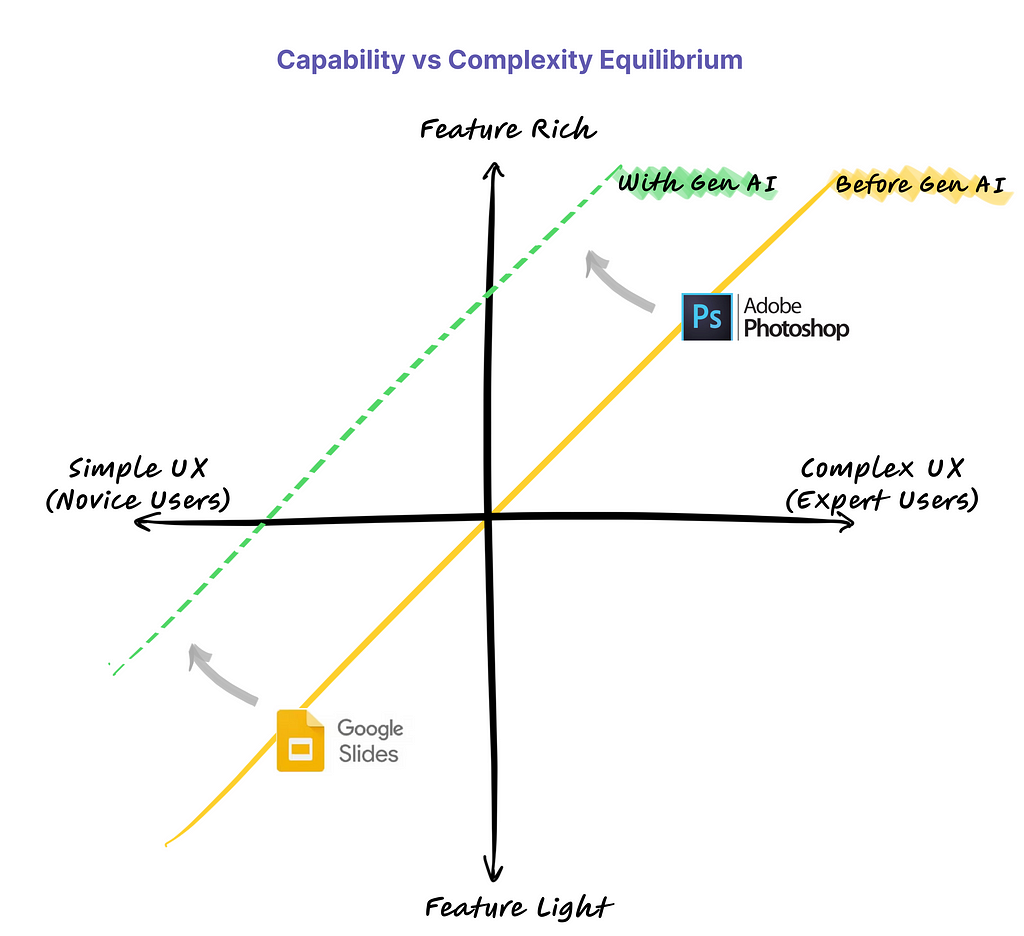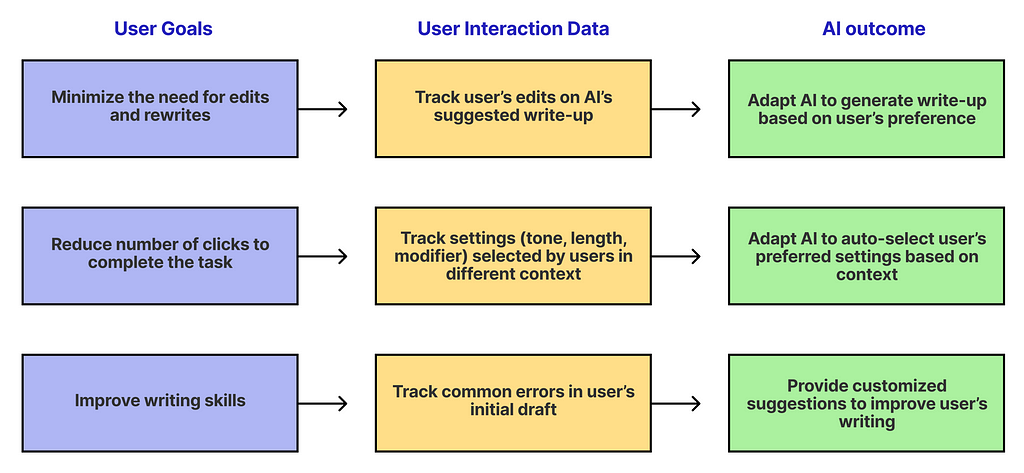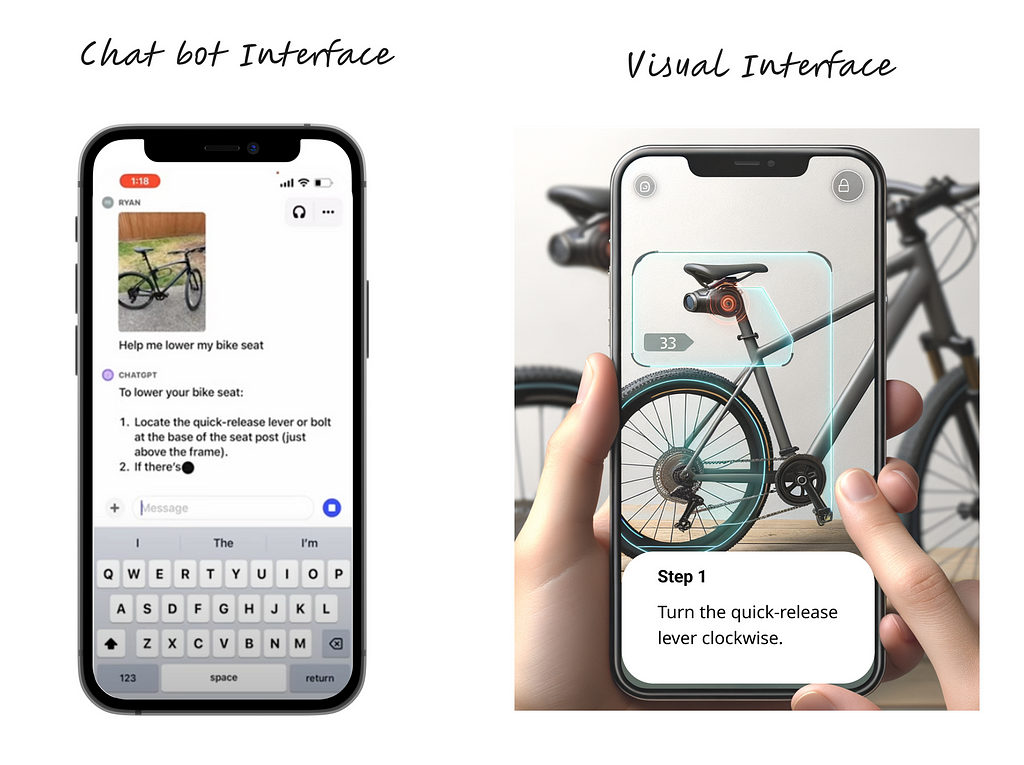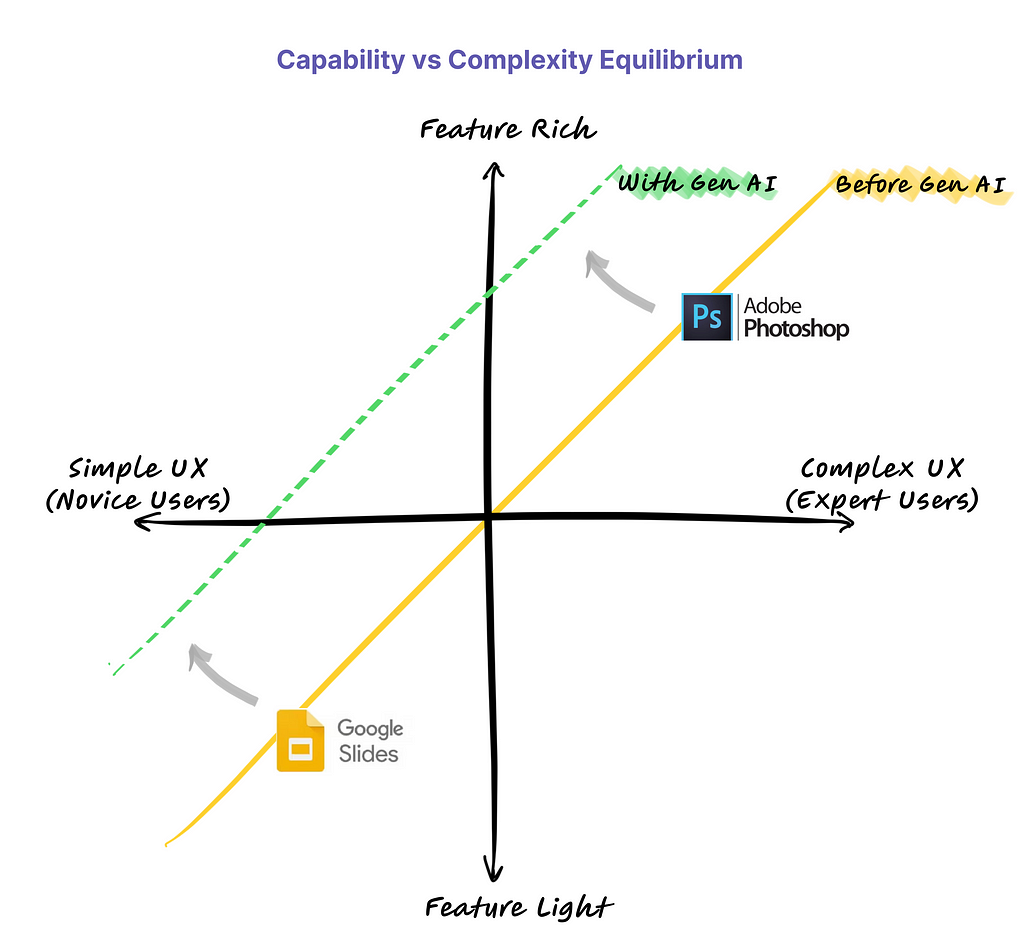
Navigating the Changing Product Landscape: From Flashy Demos to Trustworthy AI Solutions that Win Customer Trust.
For decades, product builders long accepted a seemingly unbreakable rule: as the capabilities of a product increase, so does its complexity. For users, this has often meant choosing between simplicity and power. Anyone who has grappled with advanced softwares knows the frustration of navigating through countless menus and options to find that one feature they need! It’s the classic trade-off that has, until now, dictated the user experience.
But the rise of generative AI promises to disrupt this trade-off.
Imagine the Adobe Photoshop of yesteryears: while the product boasted a staggering array of rich design features, the product became so complex that only experts could use it. Today, with generative AI, Photoshop can enable users to make requests in plain speech like “remove background” or “make this portrait pop with sharper contrast.” This is a glimpse into how AI is making powerful tools more accessible for everyone.
By interpreting natural language commands, advanced feature-rich products can now make their user experience more accessible and intuitive for users without sacrificing their sophisticated capabilities. Conversely, the existing feature-light products aimed at novice users, which typically favor simple user experience, can now offer a newfound depth of Generative AI capabilities without adding complicating the user interface.

This is the essence of the paradigm shift — where complexity is no longer the cost of capability.
As generative AI redefines the product design landscape, it’s clear that established companies with strong user bases and domain expertise have a head-start. However, success is far from guaranteed.
You can integrate a generative AI API today, but where is the moat?
I have talked with half a dozen product leaders builders just this month. Every believes that paradigm shift of Generative AI has kick started a race. In the end, there will be winners and losers. This article, brings out some of the key strategies that product leaders are leveraging to use Generative AI for delivering a differentiated offerings to their customers.
1. Tailored Experience with Proprietary Domain-Specific Data
In Generative AI, “one size fits all” approach doesn’t make the cut for specialized use cases. Generic foundation models are trained on internet data, which lacks industry-specific nuanced knowledge.
Take large vision models (LVMs) as example. LVMs are typically trained on internet images — which include pictures of pets, people, landmarks and every day objects. However, many practical vision applications (manufacturing, aerial imagery, life sciences, etc.) use images that look nothing like most internet images.
Adapting foundation models with proprietary data can vastly improve performance.
“A large vision model trained with domain-specific data performed 36–52% better than generic models for industry specific use cases.” — Andrew NG, Founder DeepLearning.AI
The narrative is similar for text-based large language models (LLMs). For instance, Bloomberg trained an LLM with proprietary financial data to build BloombergGPT, which outperforms other generic models of similar size on most finance NLP tasks. By augmenting foundation models with proprietary, in-domain data, companies can develop tailored generative AI that understands the nuances of the industry and delivers differentiated experience to meet users’ specialized needs.
2. Solving AI’s “Last Mile” Challenges
For all their impressive abilities, generative AI models are a far from being reliable enough for most real-world applications. This gap between “wow!” demos and dependable deployments is what technologists refer to as the “last mile” problem. Generative AI produces probabilistic output and have tendency to hallucinate. This is a cause of concern in many business, finance, medicine, and other high-stakes use cases. As generative models become more capable, implementing practices to ensure fairness, transparency, privacy, and security grows increasingly important.
The framework below lists various initiatives that leading companies are prioritizing to manage the “last mile” risks pertinent to their industry.

By solving difficult responsible AI challenges unique to their industry, companies can successfully integrate these powerful technologies into critical real-world applications. Leading in AI ethics will earn user trust and gain a competitive advantage.
3. Product Enhancement through Continuous Learning and Personalization
The cornerstone of crafting an exceptional, human-centered user experience is to design products that don’t just respond to users but grows and adapts with them. Leading Generative AI products will implement tight feedback loops between users and AI to enable continuous learning and deliver personalized experience.
“To build an ever-improving AI service, begin with the end-user goals in mind. Build a data-flywheel that continuously captures actionable data points which helps you assess and improve AI to better meet those goals.” — AWS, Director
Consider Grammarly, a tool designed to refine and improve users’ writing. It has recently launched Generative AI features to provide users with personalized writing suggestions.
Here’s a conceptual breakdown of how Grammarly can implement feedback loop to enhance its product aligned with different user goals:

A successful implementation requires:
- Thoughtful design of feedback loop based on user goals
- Logging usage data securely with privacy safeguards
- Scalable data infrastructure to fuel AI model adaptation
- Testing interfaces to elicit high-quality user feedback
The result is an AI that becomes increasingly customized to individual needs — without compromising privacy.
Prioritizing these human-centered feedback loops creates living products that continuously improve through real user engagement. This cycle of learning will become a core competitive advantage.
4. AI-First Design: Full Stack Optimization with AI at the Core
Realizing the full potential of generative AI requires rethinking user experience from the ground up. Bolting an AI chatbot in the application as an afterthought is unlikely to provide a cohesive experience. This requires cross-functional collaboration and rethinking of interactions across the entire product stack right from the beginning.
“Think from first principles. If you had these generative AI capabilities from the start, how would you design the ideal experience?” — Ideo, Design Lead
Consider a bike repair app. A chatbot that allows users to upload pictures of their bike and receive text instructions can be a good MVP. But the ideal UX will likely be a visual interface where:
- user open their camera and point it at the bike
- computer vision analyzes visual to highlight relevant parts of the bike
- app provides guided instructions on the live camera feed

Delivering this experience requires collaboration across teams:
- UX Design: User research and prototyping for computer vision UI
- Engineering: Data pipelines, performant APIs, caching for low-latency
- Data: Building training/evaluation datasets early to fuel improvement
- Science: Ensuring high-accuracy vision models tailored to bike repair
- Domain Experts: Insights on bike mechanics and feedback to refine AI
By bringing these perspectives together from the outset, products can deliver fluid, human-centered user experience. Companies leveraging “AI-first” design thinking and full stack product optimization will be best placed to provide differentiated value to their customers.
Conclusion: Shaping the Future of Product Design
As generative AI becomes ubiquitous, product leaders have an enormous opportunity — and responsibility — to shape its impact. Companies who take a human-centered, ethical approach will earn users trust. The key is embracing AI not just for its functionality, but for its potential to augment human creativity and positively transform user experiences. With thoughtful implementation, generative AI can expand access to sophisticated tools, unlock new levels of personalization, and enable products to continuously learn from real-world use.
By keeping the human at the heart of generative product design, forward-thinking companies can form authentic connections with users and deliver truly differentiated value. This human-AI symbiosis is the hallmark of transformative product experiences yet to come.
Thanks for reading! If these insights resonate with you or spark new thoughts, let’s continue the conversation.
Share your perspectives in the comments below or connect with me on LinkedIn.
The Generative AI Advantage: Product Strategies to Differentiate was originally published in Towards Data Science on Medium, where people are continuing the conversation by highlighting and responding to this story.
Originally appeared here:
The Generative AI Advantage: Product Strategies to Differentiate
Go Here to Read this Fast! The Generative AI Advantage: Product Strategies to Differentiate
